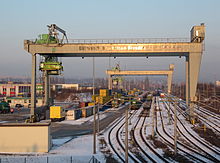Reichsbahn repair shop Dresden
The Dresden Reichsbahn repair shop is a former repair shop in the Friedrichstadt district of Dresden . From 1894 onwards it was used to repair wagons and initially also locomotives. After the political turnaround in 1990, the demand for two-axle freight cars fell rapidly and the Reichsbahn repair shop had to close in the mid-1990s.
location
The repair shop was located between the Dresden-Friedrichstadt marshalling yard and today's Emerich-Ambros-Ufer . It consisted of a wagon and a locomotive repair workshop, which were aligned diagonally to the main direction of the station tracks. In this way, many tracks could be led directly into the building and goods wagons in need of repair could be collected directly from the drainage hill and taken to the repair shop. In addition, a forge , large assembly halls and several service, storage and administration buildings were built.
history
At the same time as the marshalling yard was being built, the Royal Saxon State Railroad built the repair shop between September 6, 1890 and November 1894, which was then still known as the workshop station. In the first few years after commissioning, all normal and narrow-gauge locomotives and all types of wagons in Dresden and the surrounding area were repaired here. The plant had the highest workforce in its history in 1921 with 3000 employees; This made this company one of the largest employers in the west of Dresden.
After the establishment of the Deutsche Reichsbahn-Gesellschaft in 1924, the repair shops were asked to earn large reparations payments to the victorious powers of the First World War , which it was hoped to achieve with rationalization measures. This was accompanied by the renaming of the Friedrichstadt “main workshop” (HW) in December 1924 to “railway repair shop” (EAW) and in 1927 to “Reichsbahn repair shop” (Raw). In the first years between the wars, several new halls were built on the factory premises. In the course of a restructuring of the Reichsbahnbetriebe engaged in repairs, the Dresden Raw material handed over responsibility for narrow-gauge repairs in 1931 and for locomotive repairs to Raw Chemnitz in 1938 . Since then, locomotives have only seen quick repairs here.
During the Second World War, numerous Eastern workers , but also prisoners of war, were deployed in the Raw Friedrichstadt . From September 1944 to April 1945, an average of 500 prisoners from the Flossenbürg concentration camp worked here, guarded by an SS command. At least 79 prisoners died in Dresden; a memorial on the Emerich-Ambros-Ufer commemorates them. It was also affected by the air raids on Dresden .
In the first post-war years, the repair of all standard gauge locomotives and wagons was on the program. In the mid-1950s, the plant specialized in two-axle freight wagons , including the Kramer wagon named after Erwin Kramer in a material-friendly design without flaps and doors, and from 1964 the open freight wagon Es-u . 25,000 of the latter had been built by 1978. After that, only the maintenance of this type and freight wagons of the same design took place. In addition, the Raw carried out smaller special orders, for example the construction of the EA02 electric battery locomotive for the Dresden Park Railway in 1982 , after the EA01 had been built here in the early 1960s . Most of the park railway cars were also built here.
A turning point for the work was the political turning point in eastern Germany in 1989/90. Freight traffic fell sharply and the demand for freight wagons fell significantly. The resulting reduction in the number of freight wagons fell victim to the outdated two-axle wagons. Due to the spatial conditions, it was hardly possible to react to these changed market conditions. The halls and the transfer platform construction did not allow maintenance of wagons longer than 15 meters.
Vehicle maintenance therefore expired in the early 1990s. Many of the cars built earlier were dismantled here by the workforce before the plant closed in the mid-1990s and was demolished in 1998 in favor of the planned freight center.
literature
- Kurt Kaiß and Matthias Hengst: Dresden's Railway: 1894-1994. Alba publication, Düsseldorf 1994. ISBN 3-87094-350-5
Individual evidence
- ↑ a b c d e Kaiß / Hengst: Dresdens Eisenbahn , Chapter: The repair shop Dresden-Friedrichstadt, page 211ff.
- ↑ International Tracing Service HQ: Catalog of Camps and Prisons in Germany and German-occupied Territories, Arolsen, 1949, p. 238 and 1950, p. 560; Reprinted in: Martin Weimann (Ed.): The National Socialist Camp System, Frankfurt / Main, 1998.
- ↑ Wolfgang Benz and Barbara Distel (eds.): Flossenbürg: The Flossenbürg Concentration Camp and its satellite camps , chapter Dresden (Reichsbahnausbesserungswerk) , page 85ff.
Coordinates: 51 ° 3 ′ 13 ″ N , 13 ° 41 ′ 59 ″ E

